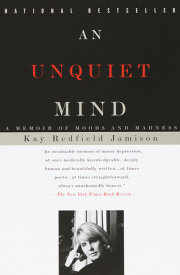1
No Tickets for That Altitude
The resident doctor said,
“We are not deep in ideas, imagination or enthusiasm—
how can we help you?”
I asked,
“These days of only poems and depression—
what can I do with them?
Will they help me to notice
what I cannot bear to look at?”
—From “Notice”
“Darkness honestly lived through is a place of wonder and life,” Robert Lowell wrote. “So much has come from there.” It was October 1957 and he was forty, writing poetry “like a house a fire,” and taking darkness into “new country.” It was, he said, the best writing he had done, “closer to what I know” and “oh how welcome after four silent years.” The new poems became the heart of Life Studies, “perhaps the most influential book of modern verse since T. S. Eliot’s The Waste Land.” The poems, most written at the boil in a few months’ time, left their mark: “They have made a conquest,” wrote a reviewer. “They have won . . . a major expansion of the territory of poetry.”
In December 1957, after his summer and fall blaze of writing, Lowell was admitted to a mental hospital severely psychotic. It was his fifth psychiatric hospitalization in eight years. He was involuntarily committed to the Boston State Hospital and then transferred to the Massachusetts Mental Health Center (until 1956 known as Boston Psychopathic Hospital). In early 1958 he was transferred yet again, this time to McLean Hospital, where his great-great-grandmother had been institutionalized more than a hundred years earlier. The repetition of circumstance was not lost on Lowell; Life Studies had begun with a steeping in his ancestry. Harriet Brackett Spence Lowell, he had come to believe, was the one who had brought poetry into the Lowell line.
Lowell told the doctor who admitted him to the Massachusetts Mental Health Center that the preceding months, September and October 1957, had been “some of his most productive months of writing poetry.” It was the pattern he had come to know well: first, the weeks of intense, fiery writing. Then the spike into mania, and finally, as night follows day, the “dust in the blood” of depression. His psychiatrist wrote in Lowell’s medical chart what many of his doctors were to observe: “The patient has had a series of breaks,” she wrote, “all in the light of unusual literary output.” Much had come from the darkness, but not without a cost.
This book is about fire in the blood and darkness; it is about mania and the precarious, deranging altitude to which mania ascends. It is about the poetic imagination and how mania and imagination come together to create great art. But it is as much and more about the vital role of discipline and character in making art from inborn gift. Poetry may come from an unhappy and disordered life, Lowell wrote, “but a huge amount of health has to go into the misery.” Without question, Lowell’s attacks of mania spurred his work; they also brought pain to him and to those he loved. Things he had done when he was manic haunted him when he was well. They were public and they gave fodder to his detractors. Yet Lowell came back from madness time and again, reentered the fray, and kept intact his friendships. He kept his wit and his capacity to love. He went back to his work.
This faculty for regeneration is uncommon; so too is the courage to face, and to write from, the certainty of impending madness. Creating poetry that expands the territory is rarer still. Lowell’s poetic imagination was tethered to an unstable but disciplined mind; it forged his work and branded his life. Mania took his poetry where it would not have gone, to an altitude for which, as he wrote in the first poem of Life Studies, “there were no tickets.”
“My trouble,” Lowell wrote to his friend, the poet Elizabeth Bishop, is “to bring together in me the Puritanical iron hand of constraint and the gushes of pure wildness. One can’t survive or write without both but they need to come to terms. Rather narrow walking—.” Lowell turned to his use the warring elements of what one doctor described as a “rock crystal” will, “glittering, very hard, and very definite in its formation,” and the mania that lay almost beyond its reach; the fight gave a yield in art and a life graced but damaged. No measure of will could prevent madness, any more than it could bring down a storm at sea. It was the contending, the struggle, the effort that marked Lowell’s life and set the terms of his writing and ambition. A century earlier, Byron, no stranger to ungovernable moods, had written, “Yet see—he mastereth himself—& makes / His torture tributary to his will.” So too did Lowell.
This book is not a biography. I have written a psychological account of the life and mind of Robert Lowell; it is as well a narrative of the illness that so affected him, manic-depressive illness. This disease of the brain bears down on all things that make us human: our moods, the way we see and experience the world, the way we think, our changing capacities of energy and will and imagination, our desires, the gift to create, our determination to live or die, our expectation of the future, our sanity.
My interest lies in the entanglement of art, character, mood, and intellect. My academic and clinical field is psychology and, within that, the study and treatment of manic-depressive (bipolar) illness, the illness from which Robert Lowell suffered most of his life. I have studied as well the beholdenness of creative work to fluctuations in mood and the changes in thinking that attend such fluctuations. Mood disorders, depression, and bipolar illness, occur disproportionately often in writers, as well as in visual artists and composers. Studying the influence of both normal and pathological moods on creative work is critical to understanding how the mind imagines.
We know mania and depression to be ancient diseases, described by Hippocrates five hundred years before Christ and intensively studied by physicians and scientists in the centuries since. Mania is an unstable and complex state. It is seductive and blinding to those who are caught up in it, laden with risk and energy. It can bolt the mind into new regions and propel it to act upon ideas. Mania insinuates its way into its hosting brain: intoxicating enough to be dangerous, original enough to be valuable. Narrow walking indeed.
If it were only Robert Lowell afflicted by mania it still would bear thought because mania was a dominant force in the life and work of a major poet. Because it is a part of the lives of so many other writers and creators, however, it is of more general interest. Mania has had a subtle as well as a blunt impact on human history: it has struck those who founded religions and empires, discovered the laws of nature and mapped new lands; it has set fire to the imaginations of those who write, paint, and compose. Mania is important to understanding many who create; it occupies rare real estate in the brain, sharing permeable borders with the normal mind, madness, and imagination.
This book will explore the patterns of Robert Lowell’s mania and the mutability of his moods, as well as his long periods of depression, all of which shaped his temperament, character, thinking, and imagination. It will look at the forces Lowell brought to bear against his illness: his character and New England heritage; his discipline, intellect, capacity for friendship, and iron-laced upbringing. Lowell had a severe form of manic depression. He fought to control, fend off, and make sense of his manic attacks and was acutely aware that his control was incomplete. Instability and the relentless recurrence of his illness hardened his discipline while mania impelled and stamped his work. Knowing that his sanity was subject to forces beyond his control marked his poetry and darkened his life philosophy.
“We face the precariousness of keeping alert, of keeping alive in the triple conflict between madness, death and life,” Lowell once said. “We must bend, not break.” Lowell was dealt a hand of cards high in privilege and poetic imagination but he also received dark cards, impossible to play, that broke him time and again. There are no rules for how to play such cards; no one is provided a map to navigate madness or depression. I will argue that Lowell played his cards with courage and imagination; above all, he did not fold. It would have been easy to do so. Much of his adult life was engaged in a battle against madness or fear that it would come back, contending with the suffering that it caused him, and the pain it caused others.
Nothing about Lowell’s mind was simple. The English poet and novelist Alan Brownjohn described spending time in his company: “We left feeling completely kind of drained, shattered, stupefied really . . . literary conversations with him were . . . tiring in the sense that you felt every nerve was stretched. It was partly the man’s knowledge, which was encyclopedic, partly the sort of darting perceptions and intuitions on behalf of you for what you were going to say next. He made links and connections for you in this slightly manic—and paranoid—way.”
Any attempt to understand such a mind must be partial and qualified; the usual limits of understanding another’s mind are compounded when trying to understand Lowell, a man who thought in metaphor, lived in history, and whose mind was engaged in a restless, stupendously elaborate game of three-dimensional chess. Lowell’s mind was of a lurching, revising originality.
“Metaphor was his reality, not the original fact,” recounted his friend Esther Brooks. Lowell made her feel, his friend the literary critic Helen Vendler said, “like a rather backward evolutionary form confronted by an unknown but superior species. And when one asked what the name of the species was, the answer came unbidden: Poet.” Lowell, to the philosopher Isaiah Berlin, was “a man of genius”: complex, likable, and bewildering, he added, but a genius.
Lowell’s originality and breadth of thinking were matched by prodigious energy. Ideas flew. Brooks, a longtime friend, said that Lowell’s way of looking at things was “so completely original that you yourself began to see everything from a different perspective. Hours meant nothing to him when he was interested. Day turned into night and night back into day while he, with his seemingly limitless stamina, worried an idea, rejected it, discovered another, built mental pyramids, tore them down, discoursed on the habits of wolves, the Punic Wars, Dante, Napoleon, Shakespeare, Alexander the Great, politics, his friends, religion, his work, or the great noyade at Nantes. Whatever the subject it all came forth as though it were being pushed at you, helped on its way by that outward prodding palm. Sometimes this incredible energy of his would exhaust you and you would suddenly feel like screaming, or running away in search of some undefined moment, some unexamined fact, some purely sensuous reaction to beauty.”
I do not believe, as a psychologist or from my life, that anyone can more than partially understand the mind of another. When I teach psychiatry residents and graduate students about psychotherapy, I stress the respect one must keep for the abyss between what one thinks one knows and what one actually knows about another individual’s mental life. That abyss, unless its existence is kept in mind, will stand in the way of empathy and clinical acuity. We have a precarious understanding of our own thoughts and emotions, much less another’s. There are limits, but one can hope, within those limits, to create some sense of a life and to bring a fair mixture of compassion and dispassion to the task. Lowell’s mind, however many worlded and metaphoric, has a lighted way into it. His autobiographical writings, letters, poetry, and prose contain critical insight into his writing patterns and the evolution of his poetry; they allow a close look into his childhood and family, friendships, marriages, and the ongoing struggle he had with his mental illness. His letters, particularly, give a sense of who he was as a person, poet, father, and friend.
Looking back over thirty years of writing, Lowell said, “My impression is that the thread that strings it together is my autobiography.” Yet of course his poetry was spun from his imagination as well as from fact, and fact itself, like memory and mood, is mutable. “From year to year,” he wrote, “things remembered from the past change almost more than the present.” His “autobiographical poems,” he made clear, are “not always factually true. There’s a good deal of tinkering with fact. You leave out a lot, and emphasize this and not that. Your actual experience is a complete flux. I’ve invented facts and changed things, and the whole balance of the poem was something invented.” Yet, he said, if the writing is autobiographical, “you want the reader to say, this is true.” The memory mattered, certainly, but also imagination. He quoted the poet G. S. Fraser that there is a real sense “in which good poets are, when you meet them, like their works.”
Lowell’s letters, posted before revising and time could alter them, are particularly helpful in understanding his life. So too are the writings of those who knew him. Most of his friends and lovers, as well as the three women to whom he was married, were writers and described in detail his personality and work, as well as the dramatic changes in his behavior when he was manic. Lowell was interviewed at length by journalists and critics, and his primary biographer, Ian Hamilton, conducted comprehensive interviews with many of those who knew Lowell best. The original tape recordings of these interviews, together with Hamilton’s meticulous notes and correspondence, are of significant help in any attempt to understand Lowell. They are archived at the British Library and provide an invaluable portrait of Robert Lowell as a poet, husband, and friend. The interviews reveal the devastating impact of his mania on those who experienced his attacks at close hand, but they also give a good sense of why so many who knew him well loved him deeply.
Hamilton’s biography of Lowell, published in 1982, was carefully researched and written; it was widely read in the literary community and its impact on Lowell’s reputation as a poet and man was lasting and negative. The Lowell that Hamilton chose to portray is loutish, mad, humorless, a snob, and an overrated poet. There is much detail about Lowell’s breakdowns but relatively little about how his illness affected his poetry. Lowell’s capacity to live and work in the shadow of his madness is alluded to but not brought out in meaningful detail. His struggles and suffering, except for the suffering he caused to others, are not much in evidence. The cumulative and corrosive toll of Lowell’s disease on his personality, most apparent in the last years of his life when he lived in England, receives disproportionate weight over the longer years of his life in America when he was in better psychological health. Negative excerpts from reviews of Lowell’s work and interviews conducted by Hamilton predominate over the positive ones, which are given short shrift.
Artists and writers whose lives were spelled with madness and turmoil—Schumann, van Gogh, Woolf—have tended to attract sensationalist press and biography. Their art is crowded out by the drama of insanity or suicide. Irrational or shocking behavior makes better copy than the uses to which the turmoil is put and the discipline that shapes and constrains it. Hamilton’s biography of Lowell is no exception to this, perhaps in part because he knew Lowell toward the end of his life when Lowell’s mania was either on the simmer or full-blown, pernicious; a time when his behavior was often abrasive and when he lived in the determining light of his fame and madness. Simon Gray, the playwright and a friend of Hamilton, acknowledges this. “Towards the end of the life of Robert Lowell,” Gray writes, “you can feel all Ian’s unwritten revulsion working its way through the prose.” Exactly because Hamilton did know Lowell and was, as well, a poet, his biography has had a lasting impact. Paul Mariani’s biography of Lowell, Lost Puritan, is more sympathetic—more human, more complex, more appreciative of both the man and his work—but it has been less influential.
“Robert Lowell was notably unlucky in Ian Hamilton’s major biography,” wrote the poet and critic Richard Tillinghast. “[It was] a damagingly wrong-headed and skewed picture.” One could wish, he said, for an account that would give a more rounded picture of the man “his friends put up with, laughed about, became exasperated with, but always admired and deeply loved.” Another critic observed that “many readers and critics tend to regard Ian Hamilton’s 1982 biography as the book that broke the back of Robert Lowell’s reputation or, at the very least, turned his fame into infamy.” Jonathan Raban, a writer and friend of Lowell who knew him well, described the book as “pitiless and strangely incomprehending of his illness.”
Grey Gowrie, a poet, close friend, and pallbearer at Lowell’s funeral, concurs with the criticism of Hamilton’s biography. It “missed his humor. It got the snaffle and bit but is missing the horse. Lizzie [Elizabeth Hardwick, Lowell’s second wife] said after she read it that one would never know why we all loved and cared about him.” Hardwick’s point is one reiterated by many who knew Lowell best.
Lowell’s daughter, Harriet Winslow Lowell, believes that the relentless portrayal of madness fails to capture the father she knew: “Every serious story ends in buffoonish insanity, a manic affair and poetic reinvention,” she states. “The breakdowns did happen, but the real life was full of unknowns and possibilities. . . . The hilarity and fun of being with the man is inadequately conveyed. . . . He had an enormous capacity for regeneration, hard work and a desire to re-connect with his family and friends on a deep level and engage with the world, in the midst of a deeply moving struggle with severe mental illness. Above all he was a poet. . . . He had a terrible disease, but was charming, mischievous and full of fun.” His view of the world was dark, she says, but he was not. “I am not trying to say the ill man did not cause real pain and also the well man. It was a messy life in many respects.”
I am indebted to Harriet Lowell, not only for talking with me about her father but for giving me permission to obtain and review his medical records. These provide a detailed account of his psychiatric illness and hospitalizations, as well as his thoughts and feelings about his illness and the relation of his mania and depression to his poetry. His fear that his illness would recur is palpable in the notes made by his doctors; so too is the remorse he felt over the hurt he caused his family and friends when manic. This is the first time that Lowell’s hospital records have been made available. (See Appendix 1 for details of obtaining and using these records.) It is also the first time that Lowell’s daughter has spoken about her father’s work, her memories of him as a father, and her parents’ marriage.
While I was doing the research for this book, Harriet Lowell asked if I would be interested in looking through the contents of the briefcase her father had been carrying with him at the time of his death in September 1977. It was a deeply moving thing to do. In addition to finding his glasses, his checkbook, a note from Elizabeth Bishop written to him shortly before he died, and a listing of the items he was carrying with him at the time he was pronounced dead at Roosevelt Hospital in New York, I came across a red hardbound appointment book. It contained more than two hundred pages of Lowell’s handwritten notes, including fragments and drafts of poems, many of which found their way into his last book, Day by Day. The notebook, previously unknown, spans a critical year in Lowell’s life, 1973, a year in which he published three volumes of verse, two of them to blistering controversy, one that received the Pulitzer Prize. During 1973, Lowell’s poetry changed significantly in tone and focus. The writing in the notebook—marked by themes of wandering and an agitated search for home, for peace; of madness; of love and aging and death—is valedictory and wrenching.
I have drawn upon this notebook, together with Lowell’s medical and psychiatric records, interviews I conducted with many of those who knew him well, and the existing literary, biographical, and autobiographical material, to give what I hope is a fresh reading of Lowell’s life and work.
Copyright © 2017 by Kay Redfield Jamison. All rights reserved. No part of this excerpt may be reproduced or reprinted without permission in writing from the publisher.








